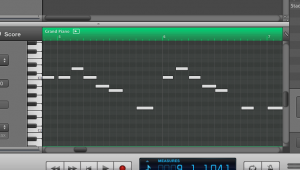In music, the gaps between the notes are more important than the notes themselves.
This sounds like a quotation from a handbook on either philosophy or the obscure end of nuclear physics – but it’s true.
You can start a tune on any note you like, to suit your voice or your instrument. Whether the tune sounds like what you intended, or not, depends on you getting the right gaps between the first and second, second and third note, and so on.
This is a picture of a melody in midi format, a very neat way of showing sounds on a computer.
Each dash is a note. If you have good eyesight you will see that the black background is a grid of small rectangles. On the left, the piano keyboard shows which note the horizontal dashes represent. Up and down = pitch.
The columns represent time: how long each note is and how soon the next one is played. Short and long = rhythm.
As long as the pattern of dashes stays the same, the tune will always be the “Sonnez les matines” line from Frere Jacques. The first note is the end of the previous line, by the way.
Midi graphics are helpful because they are very, very logical, in a way that standard music notation is not. It is entirely obvious in midi, for instance, that the vertical (pitch) gap between notes 5 and 6 is smaller than the gap between notes 4 and 5. Those notes (and the repeated ones, 11 and 12) are right next door to each other.
If you sing that line it feels as though all the notes for
“Sonnez les mati-” are next door to each other. The midi shows you that some next-door neighbours are closer than others, and that it’s only that last pair of notes that are only one step apart.
This is a very long introduction to the latest “Term of the Week”, which is semitone. It is so long that I’ve made it a post in its own right but we have finally got to the point. That gap between notes 5 and 6, one step on the midi grid, that’s a semitone.

